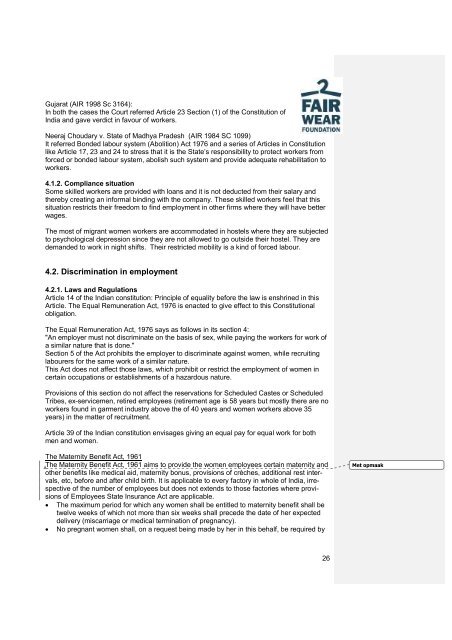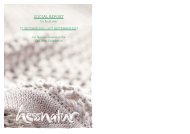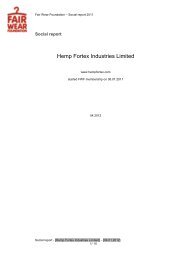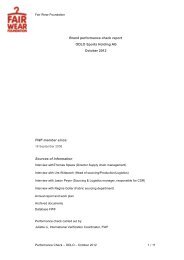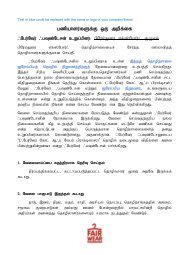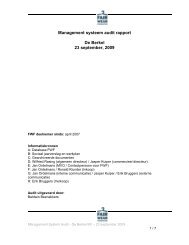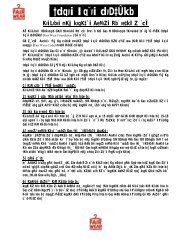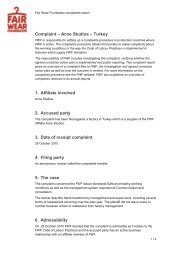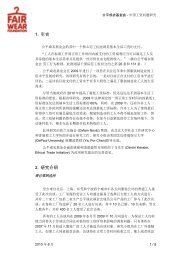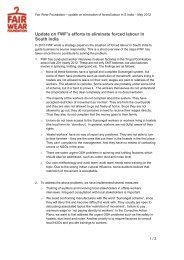Background Study Tirupur - Fair Wear Foundation
Background Study Tirupur - Fair Wear Foundation
Background Study Tirupur - Fair Wear Foundation
You also want an ePaper? Increase the reach of your titles
YUMPU automatically turns print PDFs into web optimized ePapers that Google loves.
Gujarat (AIR 1998 Sc 3164):<br />
In both the cases the Court referred Article 23 Section (1) of the Constitution of<br />
India and gave verdict in favour of workers.<br />
Neeraj Choudary v. State of Madhya Pradesh (AIR 1984 SC 1099)<br />
It referred Bonded labour system (Abolition) Act 1976 and a series of Articles in Constitution<br />
like Article 17, 23 and 24 to stress that it is the State’s responsibility to protect workers from<br />
forced or bonded labour system, abolish such system and provide adequate rehabilitation to<br />
workers.<br />
4.1.2. Compliance situation<br />
Some skilled workers are provided with loans and it is not deducted from their salary and<br />
thereby creating an informal binding with the company. These skilled workers feel that this<br />
situation restricts their freedom to find employment in other firms where they will have better<br />
wages.<br />
The most of migrant women workers are accommodated in hostels where they are subjected<br />
to psychological depression since they are not allowed to go outside their hostel. They are<br />
demanded to work in night shifts. Their restricted mobility is a kind of forced labour.<br />
4.2. Discrimination in employment<br />
4.2.1. Laws and Regulations<br />
Article 14 of the Indian constitution: Principle of equality before the law is enshrined in this<br />
Article. The Equal Remuneration Act, 1976 is enacted to give effect to this Constitutional<br />
obligation.<br />
The Equal Remuneration Act, 1976 says as follows in its section 4:<br />
"An employer must not discriminate on the basis of sex, while paying the workers for work of<br />
a similar nature that is done."<br />
Section 5 of the Act prohibits the employer to discriminate against women, while recruiting<br />
labourers for the same work of a similar nature.<br />
This Act does not affect those laws, which prohibit or restrict the employment of women in<br />
certain occupations or establishments of a hazardous nature.<br />
Provisions of this section do not affect the reservations for Scheduled Castes or Scheduled<br />
Tribes, ex-servicemen, retired employees (retirement age is 58 years but mostly there are no<br />
workers found in garment industry above the of 40 years and women workers above 35<br />
years) in the matter of recruitment.<br />
Article 39 of the Indian constitution envisages giving an equal pay for equal work for both<br />
men and women.<br />
The Maternity Benefit Act, 1961<br />
The Maternity Benefit Act, 1961 aims to provide the women employees certain maternity and<br />
other benefits like medical aid, maternity bonus, provisions of crèches, additional rest intervals,<br />
etc, before and after child birth. It is applicable to every factory in whole of India, irrespective<br />
of the number of employees but does not extends to those factories where provisions<br />
of Employees State Insurance Act are applicable.<br />
• The maximum period for which any women shall be entitled to maternity benefit shall be<br />
twelve weeks of which not more than six weeks shall precede the date of her expected<br />
delivery (miscarriage or medical termination of pregnancy).<br />
• No pregnant women shall, on a request being made by her in this behalf, be required by<br />
26<br />
Met opmaak


